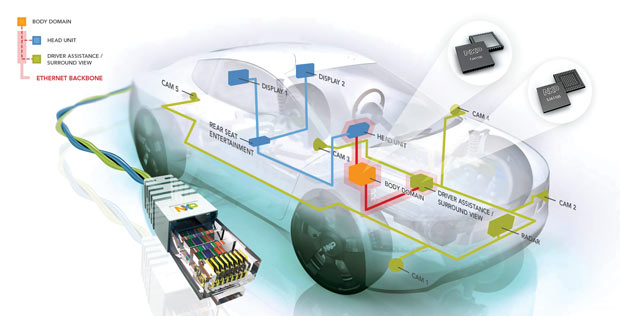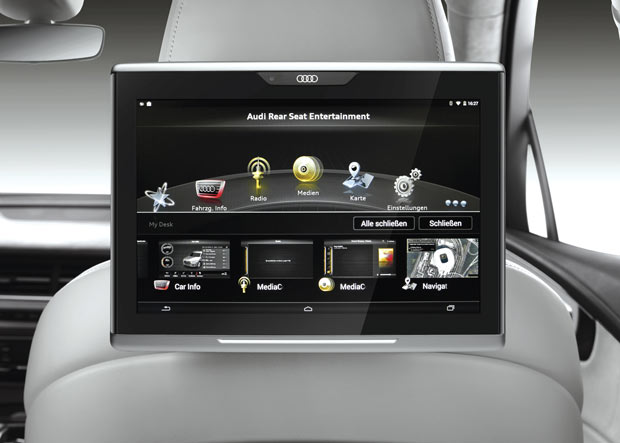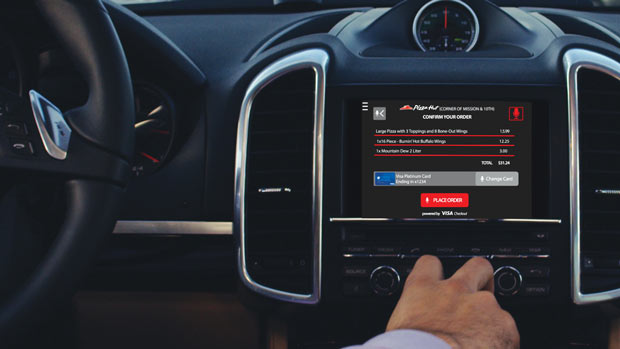
Is it a car or a computer? It’s both. Image courtesy of NXP Semiconductors N.V.
Latest News
December 1, 2015
After decades of incremental improvement in visible technology, the automobile has undergone drastic changes in the last 10 years. Perhaps the most significant of those changes is the incorporation of connectivity, including Internet access and wireless data communications: the connected car.
The connected car includes music and audio, smartphone apps, navigation, roadside assistance, voice commands, contextual help/offers, parking apps, engine controls and car diagnosis functions. Further, driver assistance and even driverless cars are transforming the story of personal transportation. It will take a decade or more to approach that goal, but the fact that it is within reason is a testament to the tremendous advances in automated control and connectivity.
More vital uses of automotive intelligence and connectivity include diagnostics and prediction. By providing more detailed data and better ways of analyzing that data, automobile performance can be optimized and potential problems can be predicted. Further, automated decisions can be made in real time, enabling the vehicle to quickly adapt to changing technical or environmental situations.
Driving these changes is a combination of high-performance embedded processors, unique computing and software innovations, a vision of networking between previously separate automotive systems, and the addition of wireless communications to deliver engineering innovations to the driving experience.
Connected Systems in the Car
Just what is connected? It’s useful to divide this phrase into three distinct categories: connected within the car; connected between car and a back-end computing infrastructure; and connected with other cars. These categories represent the major initiatives for the automotive industry in terms of connectivity, and also involve different goals and technologies.
Connected within the car is farthest along. Most current model cars have multiple processors, and are using the legacy CAN (controller area network) bus for connectivity. A CAN makes it possible to move data around reliably, so that data can be shared between automotive subsystems. For example, the engine emission sensors send data to instruments detailing measurements of gasses, which are evaluated and presented to indicator lights and to instruments that are used in service facilities. This data is usually transmitted on the vehicle CAN bus between engine systems, emission monitors and displays.
The ability of cars to exchange data between different subsystems provides for greater analysis, information and reaction between systems that can work interdependently. The drivetrain would benefit from real-time data on engine operation. Different sensors at different points within the engine can provide a mixture controller with a finer degree of data on fuel consumption, providing for a level of fine-tuning that simply was not possible a few years ago. This type of control is enabling higher fuel economy, less engine wear and fewer emissions.
However, CAN is limited in bandwidth, and cars are in need of greater bandwidth and connectivity than CAN is able to provide. With an average of 50 or more processors on a car, the amount of data processed has grown enormously in the past few years. Some of these are standard embedded processors, while others are specially designed using FPGAs (field programming gate arrays) or ASICs (application-specific integrated circuits). It’s not unusual for a new car to have hundreds of pounds of electronic components monitoring and controlling engine performance, fuel mix, brakes, power, drivetrain, and a host of other activities. Hybrid and electric cars have still more electronics.
Aggregating Data Off the Car
As off-car analytics become increasingly important in analyzing and optimizing auto performance, bandwidth needed to connect many cars to a central server infrastructure will likely operate alongside the CAN bus controlling in-car connectivity. Only a subset of auto data will be sent off of the car, and it is more likely that this connection will use protocols that better support traditional IT operations.
Car-to-server connectivity offers the best opportunity for near-term enhancement of automotive electronics, feedback, and improvements in car operations. Car-to-server refers to the ability of many individual cars to send data from the car to a central location in the cloud. The purpose of this data can be multifold. Data aggregated from many cars can be used for a variety of analytics. “Once we better understand events leading up to failures, we can use that data to predict failures in individual cars,” says Wensi Jin, automotive industry manager at MathWorks.
 The Audi tablet includes gesture controls, 3D sound for a concert-hall atmosphere in the car, the Audi phone box and the seamless integration of smartphones into the car. Image courtesy of Audi.
The Audi tablet includes gesture controls, 3D sound for a concert-hall atmosphere in the car, the Audi phone box and the seamless integration of smartphones into the car. Image courtesy of Audi.And data will go both ways. Once there are good data models, centralized applications can inform users to obtain service. “We could also make adjustments to systems, by downloading new software or changing parameters,” says Jin. “Outright failures are uncommon, but they are drastic events for drivers. We can make them even less common.”
Car-to-car connectivity may be the level of communication required to produce self-controlled (or driverless) cars. Today, the driverless concept cars on the road operate through a combination of real-time GPS updates and sensors on the auto’s perimeter. Initial tests indicate that they may have safety advantages over cars with human drivers, in large part because they are able to detect and react to external activities, such as other cars and pedestrians. With highly accurate maps and GPS, cars navigate between points and avoid obstacles.
But car-to-car communication makes this possible on a much larger scale. Cars within proximity to each other can exchange sensor data as well as velocity and direction. Think of it as choreography, with many cars communicating constantly in order to navigate while avoiding each other.
Getting there will be a long and involved process. While sensors and high-performance processors make this feasible today, it could be decades before enough autos possess the technology to make it worthwhile to use car-to-car communications for practical purposes.
Distracting, but Enhancing the Driver
One legitimate concern surrounding the connected car is that the many features enabled by connectivity might serve to distract the driver from his or her primary responsibility of driving the car. While it’s true on one level, on another it’s made driving safer by taking more decisions out of the hands of the driver and automating them, and making the cars safer by improving diagnostics and predictability.
That starts with collision warnings, based on sensors on the perimeter that detect close objects and those closing in on the vehicle. This involves the use of sensors on the perimeter of the vehicle. Collision avoidance follows, with cars having the ability to brake automatically, or turn to avoid obstacles. Multiply this by hundreds of cars in the immediate vicinity and you’ll see how safety is being significantly improved.
Maintenance and optimal performance are also improved through the use of analytics. Cars can be made more efficient through monitoring and feedback of data from engines, drivetrains, brakes, and other systems susceptible to wear and eventually failure. Informing cars and drivers of impending failures—and even possibly downloading fixes—is fast transforming the transportation experience.
The Technology Behind the Automobile
What makes these innovations possible? One is the use of inexpensive multi-core processors that provide for multiple independent tasks to be performed by a single processor. This architecture provides a higher level of computational capability and performance, the ability analyze data, and respond in real time.
 Visa, Pizza Hut and Accenture are developing a connected car commerce experience to test mobile and online purchases on the go. Image courtesy of Business Wire.
Visa, Pizza Hut and Accenture are developing a connected car commerce experience to test mobile and online purchases on the go. Image courtesy of Business Wire.Graphics processors are also making a significant impact. The four-core NVIDIA Tegra K1 mobile processors are driving instrument and navigation displays, for example. NVIDIA processors can also be used for fast-floating point operations in general, expanding their use into data processing and decision making.
Cloud computing is also contributing to auto connectivity. Virtually unlimited processing power on the back end makes it possible to gather data from cars, aggregate it and provide data for diagnostics, prediction and future car designs.
There is no turning back the clock on the connected car. Electronics, software and networking have only started to scratch the surface of what is possible. There will be new and different issues as our cars start looking more and more like computers, but the overall effect will be positive on both the industry and the user.
More Info:
Subscribe to our FREE magazine, FREE email newsletters or both!
Latest News
About the Author
Peter VarholContributing Editor Peter Varhol covers the HPC and IT beat for Digital Engineering. His expertise is software development, math systems, and systems management. You can reach him at [email protected].
Follow DE






